Hamburg Passenger Lists – 1881-1952
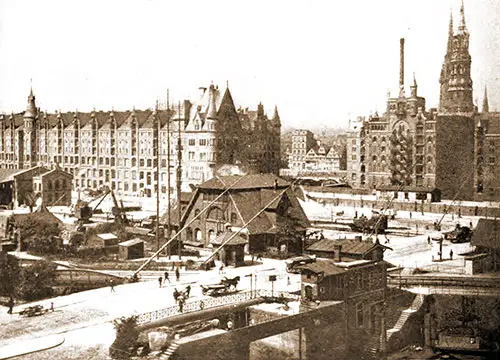
View of a Portion of the Free Port of Hamburg ca. 1912. | GGA Image ID # 1755d2cb84
Hamburg is a major transport hub in Northern Germany and is one of the most affluent cities in Europe. Hamburg became a city-state within the North German Confederation (1866–71), the German Empire (1871–1918) and during the period of the Weimar Republic (1919–33).
The entrance to the port is affected by utilizing the Elbe River. A vessel approaching the mouth of the river will first sight, in order, the four light vessels, Elbe I or outer light vessel, Elbe II, Elbe III, and Elbe IV, all of which are painted red with their names on their sides. These lights indicate the channel between the Scharhorn Riff, Neuwerker Watt, Kleiner Vogelsang, and Steilsand on the south side of the entrance and the Grosser Vogel, Gelbsand, and Hakensand on the north side.
The river, which almost forms a figure S between Cuxhaven and Hamburg, is easy to navigate. The channel is well marked with the uniform German system of red spar buoys with letters on the starboard and black conical buoys with numbers on the port.
Between the sea and Cuxhaven, the river has a navigable depth of about 37 feet at high water neap tides and about 26 feet at low water spring tides. Between Cuxhaven and Hamburg, the minimum depth is 25 1/2 feet at low-water spring tides, rising from 7 1/2 to 11 feet. The channel is now being deepened to 40 feet at mean high water. The width of the channel ranges from 660 to 1,300 feet.
The maintenance of the river was under the German government's control, which relieved the port of Hamburg of that responsibility in 1921 after the port had spent approximately $40,000,000 on improvements.
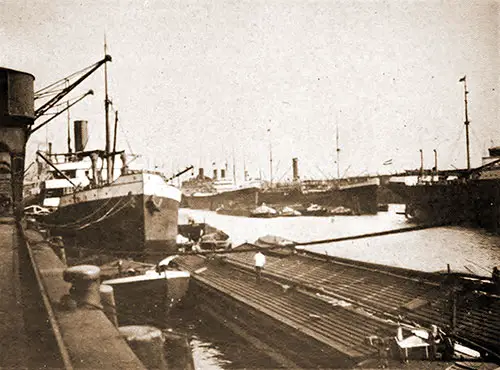
Another Busy Scene at the Hamburg Docks ca. Early 1900s. | GGA Image ID # 17566841a5
Note: Typically, only the origination and final destination ports are listed in each link. Other intermediary ports of call are not listed.
======== 1880s ========
Hamburg American Line / Hamburg Amerika Linie (HAPAG)
======== 1890s ========
Hamburg American Line / Hamburg Amerika Linie (HAPAG)
Return to Quick Links to Decades
======== 1900s ========
Hamburg American Line / Hamburg Amerika Linie (HAPAG)
- 1900-08-09 SS Fürst Bismarck - Hamburg to New York
- 1900-10-07 SS Patricia - Hamburg to New York
- 1901-07-28 SS Pretoria - Hamburg to New York
- 1902-04-22 SS Pennsylvania - New York to Hamburg
- 1902-06-21 SS Pennsylvania - Hamburg to New York
- 1903-08-22 SS Pretoria - Hamburg to New York
- 1903-08-27 SS Fürst Bismarck - Hamburg to New York
- 1905-07-29 SS Graf Waldersee - Hamburg to New York
- 1905-09-14 SS Hamburg - Hamburg to New York
- 1905-11-11 SS Pennsylvania - Hamburg to New York
- 1906-08-04 SS Pennsylvania - Hamburg to New York
- 1907-05-04 SS Meteor - Genoa to Hamburg
- 1907-06-01 SS Batavia - New York to Hamburg
- 1907-08-08 SS Amerika - Hamburg to New York
- 1908-11-12 SS Amerika - Hamburg to New York
- 1909-10-07 SS Deutschland - Hamburg to New York
Return to Quick Links to Decades
======== 1910s ========
Hamburg American Line / Hamburg Amerika Linie (HAPAG)
- 1910-06-30 SS Cincinnati - Hamburg to New York
- 1910-07-24 SS President Lincoln - Hamburg to New York
- 1910-09-08 SS Cincinnati - Hamburg to New York
- 1911-05-24 SS Graf Waldersee - Philadelphia to Hamburg
- 1912-08-03 SS Cincinnati - Hamburg to New York
- 1912-09-28 SS Patricia - Hamburg to New York
- 1912-11-01 SS President Lincoln - Hamburg to New York
- 1913-10-25 SS Pretoria - Hamburg to New York
- 1914-03-11 SS Imperator - Hamburg to New York
Nordenfjeldske Dampskibsselskap
Return to Quick Links to Decades
======== 1920s ========
American Line
Canadian Pacific Line
Hamburg American Line / Hamburg Amerika Linie (HAPAG)
- 1926-01-28 SS Albert Ballin - Hamburg to New York
- 1926-07-30 SS Deutschland - Hamburg to New York
- 1926-08-18 SS Westphalia - Hamburg to Boston and New York
- 1926-08-27 SS Albert Ballin - Hamburg to New York
- 1926-12-10 SS Cleveland - Hamburg to New York
- 1927-07-06 SS Albert Ballin - New York to Hamburg
- 1927-07-30 SS Reliance - Hamburg to New York
- 1927-08-12 SS Deutschland - Hamburg to New York
- 1927-08-16 SS Resolute - Hamburg to New York
- 1927-09-14 SS Thuringia - Hamburg to New York
- 1927-09-23 SS Deutschland - Hamburg to New York
- 1928-10-12 SS Deutschland - Hamburg to New York
- 1929-01-16 SS New York - Hamburg to New York
- 1929-03-15 SS Hamburg - Hamburg to New York
- 1929-04-05 SS New York - Hamburg to New York
- 1929-04-19 SS Hamburg - Hamburg to New York
- 1929-10-17 SS Cleveland - Hamburg to Boston and New York
Royal Mail Steam Packet Company (R.M.S.P.)
- 1921-10-22 SS Orbita - Hamburg to New York
- 1922-03-31 SS Orbita - New York to Hamburg
- 1923-03-27 SS Orduña - Hamburg to Bermuda and New York
- 1923-08-01 SS Orbita - Hamburg to New York
- 1923-08-29 SS Ohio - Hamburg to New York
- 1923-12-19 SS Orca - Hamburg to New York
- 1924-07-06 SS Orca - Hamburg to Québec and New York
- 1924-07-22 SS Ohio - Hamburg to New York
- 1924-07-29 SS Orbita - Hamburg to New York
- 1924-10-08 SS Orbita - Hamburg to New York
United American Lines (Harriman Line)
- 1922-09-05 SS Resolute - Hamburg to New York
- 1922-11-15 SS Reliance - Hamburg to New York
- 1923-07-10 SS Reliance - Hamburg for New York
- 1923-07-24 SS Resolute - Hamburg to New York
- 1923-10-21 SS Cleveland - Hamburg to New York
- 1925-05-08 SS Cleveland - Hamburg to New York
- 1925-05-19 SS Resolute - Hamburg to New York
- 1925-06-30 SS Resolute - New York to Hamburg
- 1925-07-14 SS Reliance - New York to Hamburg
- 1925-09-08 SS Resolute - Hamburg to New York
White Star Line
Return to Quick Links to Decades
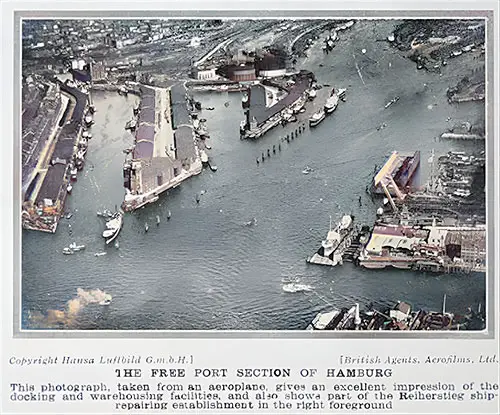
The Free Port Section of Hamburg. A Photograph Taken From an Airplane Provides an Excellent Impression of the Docking and Warehouse Facilities, and Shows Part of the Reiherstieg Ship-Repairing Establishment in the Right Foreground. Photo by British Agents, Aerofilms, Ltd. (The Syren and Shipping, 15 August 1928) | GGA Image ID # 22849726eb
======== 1930s ========
Baltimore Mail Line
- 1932-01-29 SS City of Hamburg - Hamburg to Norfolk and Baltimore
- 1932-06-24 SS City Of Hamburg - Hamburg to Norfolk and Baltimore
- 1934-03-17 SS City of Hamburg - Hamburg to Norfolk and Baltimore
- 1935-01-12 SS City Of Newport News - Hamburg to Norfolk and Baltimore
- 1936-07-11 SS City of Norfolk - Hamburg to Norfolk and Baltimore
- 1937-07-24 SS City Of Baltimore - Hamburg to Norfolk and Baltimore
Canadian Pacific Line
Hamburg America Line / Hamburg-Amerika Linie (HAPAG)
- 1930-06-07 SS Cleveland - New York and Boston to Hamburg
- 1930-08-22 SS Deutschland - Hamburg to New York
- 1930-08-29 SS Hamburg - Hamburg to New York
- 1931-05-21 SS New York - Hamburg to New York
- 1931-10-08 SS New York - Hamburg to New York
- 1932-07-16 SS Resolute - Hamburg to Scotland, Iceland, Spitzbergen, and Norway
- 1932-09-18 SS Milwaukee - Hamburg to New York
- 1933-07-27 SS New York - Hamburg to New York
- 1933-08-24 SS New York - Hamburg to New York
- 1933-12-20 SS Albert Ballin - Hamburg to New York
- 1934-08-02 SS Hamburg - Hamburg to New York
- 1934-08-09 SS New York - Hamburg to New York
- 1934-08-30 SS Hamburg - Hamburg to New York
- 1934-09-06 SS New York - Hamburg to New York
- 1935-07-11 SS Hamburg - New York to Hamburg
- 1935-08-15 SS Deutschland - Hamburg to New York
- 1935-08-21 SS Hamburg - Hamburg to New York
- 1936-05-28 SS New York - New York to Hamburg
- 1936-06-04 SS Hamburg - New York to Hamburg
- 1936-07-02 SS Hamburg - New York to Hamburg
- 1936-08-27 SS Deutschland - Hamburg to New York
- 1937-09-02 SS Hamburg - Hamburg to New York
- 1937-09-14 SS Stuttgart - Hamburg to New York
- 1938-08-04 SS Hamburg - Hamburg to New York
- 1938-11-03 SS New York - Hamburg to New York
- 1939-04-20 SS Hamburg - Hamburg to New York
- 1939-05-11 SS New York - New York to Hamburg
- 1939-06-08 SS New York - New York to Hamburg
United States Lines
- 1930-08-05 SS George Washington - Hamburg to New York
- 1930-09-08 SS America - Hamburg to New York
- 1930-09-17 SS President Harding - Hamburg to New York
- 1930-09-25 SS George Washington - Hamburg to New York
- 1931-07-28 SS America - Hamburg to New York
- 1931-09-08 SS George Washington - Hamburg to New York
- 1932-08-24 SS Manhattan - Hamburg to New York
- 1932-10-19 SS Manhattan - Hamburg to New York
- 1933-05-24 SS Washington - Hamburg to New York
- 1933-12-29 SS Washington - Hamburg to New York
- 1934-05-23 SS Washington - Hamburg to New York
- 1934-07-18 SS Manhattan - New York to Hamburg
- 1934-08-01 SS Manhattan - Hamburg to New York
- 1934-08-15 SS Washington - Hamburg to New York
- 1934-10-24 SS Manhattan - Hamburg to New York
- 1934-11-07 SS Washington - Hamburg to New York
- 1935-04-10 SS Manhattan - Hamburg to New York
- 1935-05-28 SS President Roosevelt - Hamburg to New York
- 1935-07-31 SS Manhattan - Hamburg to New York
- 1936-03-11 SS Manhattan - Hamburg to New York
- 1936-07-29 SS Manhattan - Hamburg to New York
- 1936-09-09 SS Washington - Hamburg to New York
- 1936-10-21 SS Manhattan - Hamburg to New York
- 1937-09-01 SS President Harding - Hamburg to New York
- 1938-04-20 SS Manhattan - New York to Hamburg
- 1938-04-20 SS Washington - Hamburg to New York
- 1938-06-29 SS Manhattan - Hamburg to New York
- 1938-08-31 SS President Roosevelt - Hamburg to New York
- 1938-09-14 SS President Harding - Hamburg to New York
- 1939-03-10 SS Manhattan - New York to Hamburg
- 1939-08-22 SS Washington - Hamburg to New York
Return to Quick Links to Decades
======== 1950s ========
United States Lines
Return to Quick Links to Decades
Note: Typically, only the origination and final destination ports are listed in each link. Other intermediary ports of call are not listed.
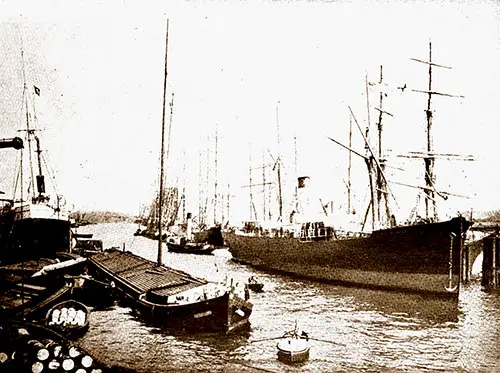
View of Hamburg Harbour ca. Early 1900s. | GGA Image ID # 175607cbeb
Hamburg is the port of arrival and departure for steamers of the Hamburg-American Line. First and second class passengers by these steamers are landed at Cuxhaven, at the mouth of the River Elbe, about 2 1/2 or 3 hours' journey by a special train that leaves on steamer's arrival passengers to the Venloer station in Hamburg.
The Customs officials pass all baggage of such passengers in the steamship company's waiting room at Cuxhaven. The Bahnhof (railway station) at Hamburg is situated about a mile from the Alster, on the banks of which the top hotels are located.
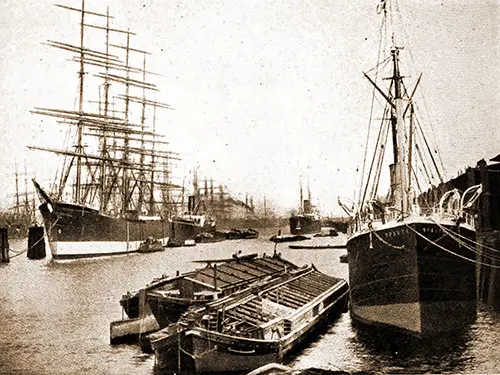
Busy Scene in Hamburg Harbour ca. Early 1900s. | GGA Image ID # 1756329d8d
The Hamburg America Line built a large ocean liner terminal at Cuxhaven in 1900. Connected directly to Hamburg by a dedicated railway line and station, it served as the major departure point for German and European emigrants until 1969 when ocean liner travel ceased.
Hamburg experienced its fastest growth during the second half of the 19th century, when its population more than quadrupled to 800,000 as the growth of the city's Atlantic trade helped make it Europe's second largest port.
With Albert Ballin as its director, the Hamburg-America Line became the world's largest transatlantic shipping company around the start of the 20th century. Shipping companies sailing to South America, Africa, India and East Asia were based in the city.
Hamburg was the departure port for most Germans and Eastern Europeans to emigrate to the United States in the late 19th and early 20th centuries. Trading communities from all over the world established themselves here.
⚠️ About Accuracy in Historical Records Research Tip
Context. The GG Archives presents passenger lists as faithfully as possible to the original documents. While OCR is generally accurate, portions of these collections—especially image captions and some transcriptions—are typed by hand and may include typographical or spelling variations. The original manifests themselves also contained clerical inconsistencies (names recorded phonetically, mid-voyage corrections, etc.).
What this means for your research:
- Search variant spellings of names (e.g., “Schmidt/Schmitt/Smith,” “Giuseppe/Joseph”).
- Cross-reference with immigration cards, passport applications, naturalization files, city directories, and newspapers.
- Treat manifests as primary sources with historical quirks—use them alongside corroborating records.
- For place names, consider historical borders and language variants (e.g., Danzig/Gdańsk, Trieste/Trst).
How to cite. When quoting a name from a manifest, consider adding [sic] for obvious misspellings and include a note such as “spelling as printed in original passenger list.”
Need help? If you spot a likely transcription error in captions, feel free to contact us with the page URL and a brief note—we love community input. 🙏
Curator’s Note
For over 25 years, I've been dedicated to a unique mission: tracking down, curating, preserving, scanning, and transcribing historical materials. These materials, carefully researched, organized, and enriched with context, live on here at the GG Archives. Each passenger list isn't just posted — it's a testament to our commitment to helping you see the people and stories behind the names.
It hasn't always been easy. In the early years, I wasn't sure the site would survive, and I often paid the hosting bills out of my own pocket. But I never built this site for the money — I built it because I love history and believe it's worth preserving. It's a labor of love that I've dedicated myself to, and I'm committed to keeping it going.
If you've found something here that helped your research, sparked a family story, or just made you smile, I'd love to hear about it. Your experiences and stories are the real reward for me. And if you'd like to help keep this labor of love going, there's a "Contribute to the Website" link tucked away on our About page.
📜 History is worth keeping. Thanks for visiting and keeping it alive with me.
